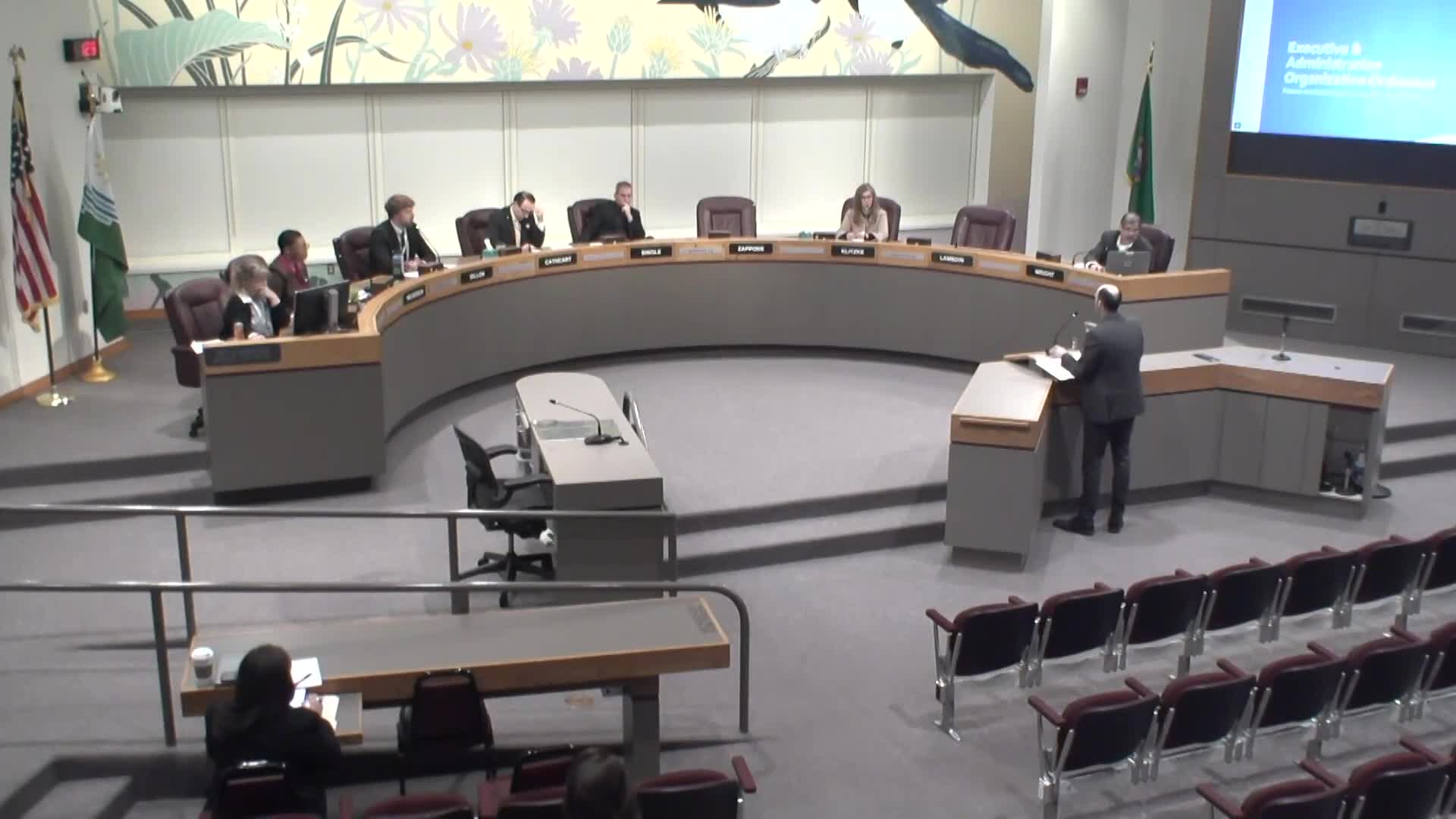City presents code cleanup and reorganization ordinance, defines divisions and names new directors
November 04, 2025 | Spokane, Spokane County, Washington
This article was created by AI summarizing key points discussed. AI makes mistakes, so for full details and context, please refer to the video of the full meeting. Please report any errors so we can fix them. Report an error »

City attorney Adam McDaniel presented an ordinance to codify the mayor's proposed executive-branch structure into the Spokane Municipal Code ahead of the mayor's budget release. The ordinance would define "divisions" (two or more administrative departments grouped together), streamline textual references, and reduce the number of named divisions from nine to seven by organizing departments into clearer divisions such as Communications & Marketing, Community & Economic Development, Finance & Administration, Housing & Human Services, Public Works, Spokane Police and a new Transportation & Sustainability division.
McDaniel said the ordinance is not the budget and does not itself create positions or authorize new FTEs; it is a code housekeeping and organizational alignment exercise required annually when the budget is prepared (00:25:49). He described the Transportation & Sustainability division's responsibilities in the context of Spokane's complex utility and transportation infrastructure and noted a resolution before the committee to appoint John Snyder as director of that division. McDaniel also described creating a crime analytics and technology unit within the Spokane Police Division, with Shauna Ernst proposed to lead that unit, and noted language integrating arts and culture liaison duties into Historic Preservation, funded by the city's admissions tax.
Council members sought clarity about whether the ordinance would authorize positions later created in the budget process and whether it could lead to new hires outside the budget cycle. McDaniel and staff said the ordinance itself creates no positions and that any hiring or FTE authorizations require a subsequent budget action (SBO or budget appropriation). Council members pressed for earlier disclosure of anticipated budget-driven position requests in order to evaluate longer-term impacts and linkage to the reorganization.
Council discussion also touched on the arts liaison integration: staff said 33% of the municipal admissions tax is appropriated to the arts commission by code, half of that is used for infrastructure and a portion has historically been contracted to Spokane Arts. The administration proposed keeping the contract amount flat for two years and using the growth in the admissions tax beyond the frozen contract amount to fund an internal arts liaison position that would provide staff support to the arts commission and take on some duties currently handled by Spokane Arts. Staff said no final decisions were made by Spokane Arts and the arts commission, and that the proposed initial change is one position for 2026 with no immediate additional FTEs.
The committee recessed briefly due to a cable transmission issue and resumed; staff offered to provide additional details to council about budget implications during the budget briefing that afternoon.
McDaniel said the ordinance is not the budget and does not itself create positions or authorize new FTEs; it is a code housekeeping and organizational alignment exercise required annually when the budget is prepared (00:25:49). He described the Transportation & Sustainability division's responsibilities in the context of Spokane's complex utility and transportation infrastructure and noted a resolution before the committee to appoint John Snyder as director of that division. McDaniel also described creating a crime analytics and technology unit within the Spokane Police Division, with Shauna Ernst proposed to lead that unit, and noted language integrating arts and culture liaison duties into Historic Preservation, funded by the city's admissions tax.
Council members sought clarity about whether the ordinance would authorize positions later created in the budget process and whether it could lead to new hires outside the budget cycle. McDaniel and staff said the ordinance itself creates no positions and that any hiring or FTE authorizations require a subsequent budget action (SBO or budget appropriation). Council members pressed for earlier disclosure of anticipated budget-driven position requests in order to evaluate longer-term impacts and linkage to the reorganization.
Council discussion also touched on the arts liaison integration: staff said 33% of the municipal admissions tax is appropriated to the arts commission by code, half of that is used for infrastructure and a portion has historically been contracted to Spokane Arts. The administration proposed keeping the contract amount flat for two years and using the growth in the admissions tax beyond the frozen contract amount to fund an internal arts liaison position that would provide staff support to the arts commission and take on some duties currently handled by Spokane Arts. Staff said no final decisions were made by Spokane Arts and the arts commission, and that the proposed initial change is one position for 2026 with no immediate additional FTEs.
The committee recessed briefly due to a cable transmission issue and resumed; staff offered to provide additional details to council about budget implications during the budget briefing that afternoon.
View the Full Meeting & All Its Details
This article offers just a summary. Unlock complete video, transcripts, and insights as a Founder Member.
✓
Watch full, unedited meeting videos
✓
Search every word spoken in unlimited transcripts
✓
AI summaries & real-time alerts (all government levels)
✓
Permanent access to expanding government content
30-day money-back guarantee

